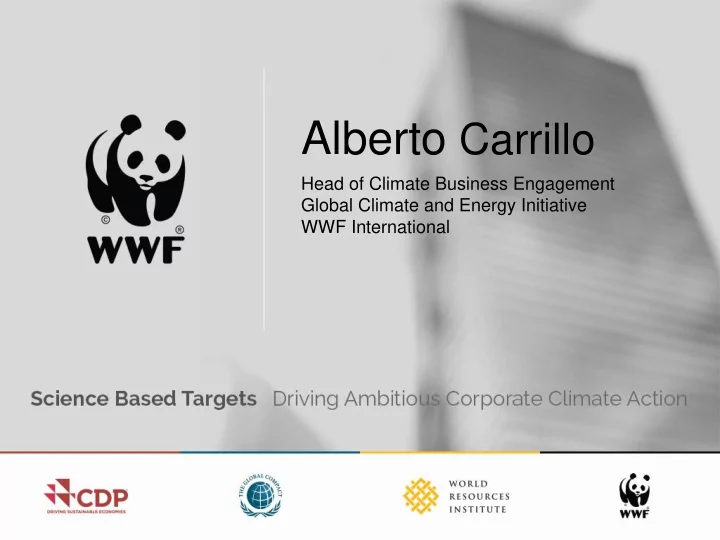

Alberto Carrillo Head of Climate Business Engagement Global Climate and Energy Initiative WWF International
What we learned from the IPCC AR5 GT CO 2 Emissions increased by 31% 3.7 – 4.8 ° C between 1990 and 2010 (of global warming by the end of the century) 1990 2000 2010 2020 2030 2040 2050
What we learned from the IPCC AR5 GT CO 2 Emissions increased by 31% between 1990 and 2010 In 2050, emissions need to be at least 41% to 72% ~1,000 GT CO2 below 2010 levels remaining carbon budget (IPCC AR5 WG3) 1990 2000 2010 2020 2030 2040 2050
What does it mean for corporate emission reduction target setting?
What is the SDA methodology? The Sectoral Decarbonisation Approach (SDA) is a freely available methodology that allows companies to set emission reduction targets in line with a 2ºC decarbonisation scenario. It is based on the 2ºC scenario (2DS) developed by the International Energy Agency (IEA) as part of its publication, Energy Technology Perspectives 2014 (IEA, 2014).
About the SDA methodology: 1. What was the development process? 2. How does it work? 3. What are the limitations / areas for development? 4. What about other methodologies?
SDA Methodology - Development process 2014 2015 1Q 2Q 3Q 4Q 1Q 2Q Consultant Initial Public Launch of Refinement appointment development consultation Version 1.0 TAG > 50 organizations c.a. 25 / companies experts
SDA Methodology - Development process
SDA Methodology – How does it work? < 2ºC RCP 2.6 2,900 GtCO 2 • Base year • Target year • Scope 1 emissions (by) • Scope 2 emissions (by) • Electricity use (by) • Activity (by) • Projected growth • Scope 1 emissions (ty) • Scope 2 emissions (ty) • Carbon intensity (ty) • Emission reductions
SDA Methodology – How does it work? Carbon intensity convergence Carbon emissions compression Homogeneous sectors: Heterogeneous sectors: • Power • Chemicals • Cement • Other processing & manufacturing industries • Iron & Steel • Other transport • Aluminium • Pulp & Paper • Transport (some sectors) • Commercial buildings
SDA Methodology – Areas for further development
SDA Methodology – Areas for further development Areas for further development • Regional differentiation • E.g. Annex 1 vs. Non-Annex 1 • Inclusion of structural parameters in key sectors • E.g. Primary vs. Secondary Aluminium • Scope 3 – Science-Based Target Setting • More in-depth analysis for additional sectors • Inclusion of LULUCF-related emissions • Inclusion of non-CO2 gases
Other science-based target setting methodologies The 3% Solution: Linear decarbonisation: Value-added CO 2 e CO 2 e GDP 49 GT 49 GT 2 ° C emissions trajectory 2 ° C trajectory 14 to 29 14 to 29 GT GT 2010 2020 2030 2040 2050 2010 2020 2030 2040 2050 www.sciencebasedtargets.org
Recommend
More recommend